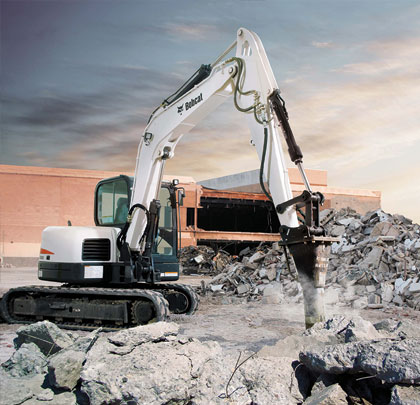10 jobs for your compact excavator
It’s common knowledge that you can dig with your compact excavator, and thank goodness for that! Traditional trenching and excavating keep thousands of construction contractors employed on jobsites every day. However, compact excavators have built-in versatility and business expansion opportunities you may not have considered.
Your compact excavator offers remarkable utility far beyond its conventional role. According to Tom Connor, Bobcat Company excavator specialist, with the right attachments and a coupler system that allows for quick and easy exchanges, here are 10 applications you probably didn’t know you could perform with a compact excavator:
- Clearing:
In wooded or overgrown areas targeted for development, compact excavators can improve properties with their ability to level dead or fallen trees and remove underbrush. Their tracks help to provide access through thick vegetation and soft terrain. Versatile attachments like midsize buckets with teeth, three-tined grapples, and rotating grapples can grab, pull, and drag saplings and rooted undergrowth, as well as sort and load material. - Park and Recreation Construction:
The machines and attachments you use to perform construction tasks for residential or commercial properties are typically needed in parks and recreational facilities. Buckets and grapples assist with cleaning and clearing land and building campsites, shelter houses, and marinas. Clamps move broken concrete, brush, logs, tree stumps, boulders, and other odd-shaped objects—even old playground equipment. Grading blades assist with rough or finish grading, backfilling, and leveling in boat ramp and beach construction and reclamation. - Trail Development:
Constructing and maintaining asphalt walking/biking trail systems and golf cart paths is tough to do with most machines, but is easier with a compact excavator equipped with a trenching bucket and grading blade. Excavators are ideal for clearing, grading, and applying fill material to prep pathways measuring approximately 5 feet wide with minimal disruption. These machines increase their value exponentially by eliminating the alternative of hand labor and shovels. They also provide the precision to chisel and sculpt sloped land, and the versatility to cut, grade, and compact fill material. - Commercial and Residential Site Prep:
Anytime there’s a need to reform land, recreate an outdoor environment, or build an elaborate hardscape, compact excavators with rotating grapples provide the grasp. The wrist-like flexibility of a rotating grapple allows operators to dig square holes, load/unload and sort material, move vegetation and pavers, and place landscape boulders. Tined grapples, paired with a clamp attachment, are perfect solutions for handling timbers and other dimensional lumber for a hardscape project like construction of waterfalls and ponds. - Demolition:
Excavators are perfectly suited to all phases of demolition work with attachments like breakers, buckets, grapples, and clamps. Armed with these accessories, operators can tear out concrete and asphalt driveways, sidewalks, trails, paths, and swimming pools. Knocking down small vertical structures, such as old buildings and retaining walls, into manageable chunks is possible, too. The cleanup is simplified with a trenching bucket or a three-tined grapple used in conjunction with a clamp to pick up and sort larger chunks for removal. - Site Prep and Grading:
Prepping a site for paving or planting could be done with your excavator fitted with a ripper to penetrate and scarify frost and hard ground. An appropriate bucket will fill in aggregate base material. Some manufacturers offer a tilt swing accessory that mounts between the excavator’s bucket and the arm to help create slopes, cut drainage ditches, or contour soil. A grading bucket can turn an excavator into a rough or finish grader, as well as a backfilling and leveling machine. - Compaction:
An excavator can be fitted with a plate compactor that is designed to compress soil from the top down, while a packer wheel attachment can compact the fill from the bottom up. These two attachments can eliminate placing workers in a trench to do hand-operated compaction or managing a walk-behind unit above ground to close up a trench. - Utility Construction and Rehabilitation:
Versatile and able to access tight areas, compact excavators and attachments, such as buckets, grapples, grading blades, and clamps, are as effective in utility rehabilitation applications as in new construction. With an aging infrastructure, there’s a growing need to refurbish aging utilities, specifically gas and sewer lines and septic tank systems. More municipalities are also realizing the aesthetic and protective value of burying overhead power lines. Some manufacturers provide swing accessories that tilt the bucket instead of the excavator to work around and under culverts, new utility lines, tree roots, and foundations to remove old infrastructure. Another application for excavators is digging entry/exit and relief pits for underground horizontal directional drilling (HDD) operations. Beyond this core function, excavators are perfectly suited to lifting components, such as product reamers, rock head assemblies, or mud motors, into place for pulling into the bore hole. - Tree Planting/Fence Posts:
Fast and accurate digging with an auger provides operators a quick method for installing fence posts, piers, and poles, or planting trees and other vegetation. - Retaining Wall Construction and Maintenance:
With a growing emphasis on climate change and wet weather patterns, many urban and rural areas are seeing increased stress on dike and levee walls. With a grading bucket and an extendable arm available on some compact excavators, walls can be reshaped by pulling fallen dirt up to a levee’s top edge to reform the shelf. The soil can then be rolled downhill and sloped with a swing accessory for improved mowing and spraying. Likewise, these same features allow contractors to groom land to construct large stone retaining walls along freeways and metropolitan interstate roadways. ■
_________________________________________________________________________
Modern Contractor Solutions, May 2013
Did you enjoy this article?
Subscribe to the FREE Digital Edition of Modern Contractor Solutions magazine.



